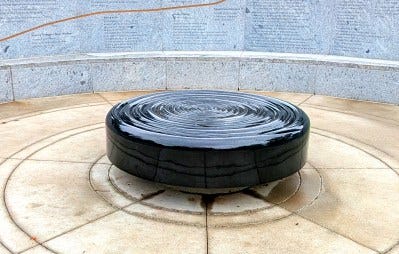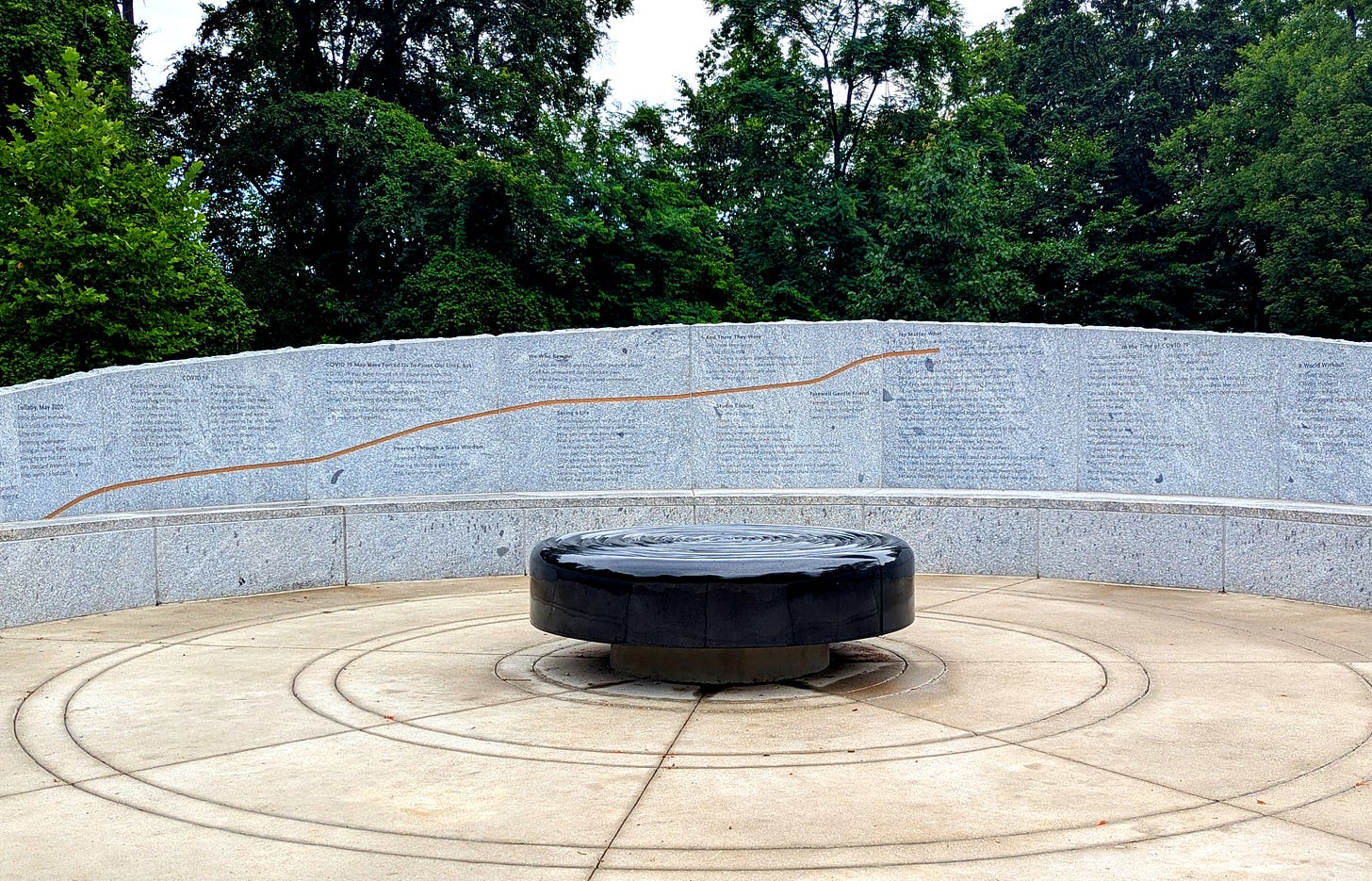A pandemic memorial stirs remembrance of the nation's trauma, the last time Trump was president
Baltimore County honors the victims of COVID-19; memorial prompts a question: Have we really moved on?
The following commentary appears this week in the Baltimore Fishbowl, a local news site that started publishing a weekly column of mine after I left The Baltimore Sun in January. One thing: At the end of the piece there’s a post-script: Artist James Dinh explains his “prayer millstone” creation, quite different from my interpretation.
During a hike through Lake Roland Park, just north of Baltimore, I came across something I did not expect to find there — a memorial to those who died in the pandemic.
I missed reports of its unveiling last November, but have since learned the following: It was commissioned by the Baltimore County government as we emerged from the pandemic three years ago. Eight local judges selected California artist James Dinh’s design from 74 submissions. The memorial is meant to honor the more than 3,100 county residents who died from the COVID-19 virus, a highly localized tribute, like the honor rolls of war dead you see in town squares.
But, of course, the pandemic killed nearly 7 million people worldwide; about 1.2 million of those deaths occurred in the United States. Disease has no boundaries.
It already seems like ages ago, but we are not so far removed from that trauma, and the memorial at Lake Roland got me thinking, in a way I did not expect, about how we’ve probably underestimated the effect of the pandemic on our American lives.
The memorial sits at the top of a rise in the parkland, a half-circle of clean, bright stone inscribed with poetry about the pandemic. It’s a simple design, but for what official sources call a “prayer millstone” that sits at the center of the memorial. This remarkable piece, dark and grooved to suggest the ripples that result from a stone tossed into a lake, seems symbolic of the widespread effects of the COVID-19 virus. That it’s called a “prayer millstone” suggests a place for meditation on a traumatic period in the nation’s history: Literally, a millstone is used to grind things down. Figuratively, it could mean a heavy burden, something that is difficult to evade or escape. Either way, the symbolism is stark.
Dinh’s simple design stirs up memories of 2020-2023, when life quickly changed for all of us — away from work and school, isolated at home; unable to visit family, especially elderly relatives; restaurants and bars closed; doctors, nurses and other caregivers stressed out and burned out; masking, testing for infection, then getting the shots.
We have moved on from all that, but not without a sense of lingering change. People in all walks of life still talk about how the pandemic hurt business, hurt careers, hurt students, hurt downtowns (and not just Baltimore’s), hurt our sense of community. The pandemic affected all of us, but not really in a communal way; we were too isolated to have the physical sense of unity against a common foe. And the pandemic compounded the social and political divisions that had become more pronounced in the Trump era.
An effective leader would have given the nation a sense of unity against a common enemy. Instead, the initial denial of a mass threat and, later, denigration of science in the MAGA world made things worse.
“In the final year of Donald Trump’s presidency, more than 450,000 Americans died from COVID-19, and life expectancy fell by 1.13 years, the biggest decrease since World War II,” a panel of public health professionals reported in Scientific American. “Many of the deaths were avoidable; COVID-19 mortality in the U.S. was 40 percent higher than the average of the other wealthy nations in the Group of Seven.”
For this and other reasons, Americans refused to give Donald Trump a second term as president.
And yet, four years later, here we are again. This time, Trump and his administration are determined to further denigrate science and threaten the nation’s health — not through incompetence, but through sinister intention. We now have Robert F. Kennedy Jr., an anti-vaccine crackpot, as secretary of health. We have seen large, arbitrary and seemingly punitive cuts in funds for the National Institutes of Health. Congressional Republicans appear eager to deprive millions of low-income Americans of government-subsidized health care and food benefits.
In March, a large, colorful image of Dr. Anthony Fauci was removed from an inspirational mural at NIH, a petty purge of a doctor whose actions saved countless lives during the pandemic.
So, no, we have not moved on.
We have regressed.
We are more vulnerable, less safe because of Trump’s inexplicable and inexcusable attacks on the nation’s health infrastructure.
I was glad to see the memorial to victims of the pandemic in Lake Roland Park. But it’s not like a war has ended. When a war ends, there is a period of peace. Troops come home. Honor rolls are finalized, memorials created. There’s a sense of finality, hope for the future and a degree of faith that we’ve learned something.
Does anyone feel that way now, in the wake of the pandemic, with Trump in office again? The only real hope remains, as always, in the American people. Only we can force a course correction back to a better, healing future for this traumatized nation.
-o-
I asked James Dinh about his “prayer millstone.” His response arrived too late for my original column in Baltimore Fishbowl. His intended meaning is quite different from my interpretation, but that’s one of the great things about art.
“When I started the design process for the memorial, I was inspired by the historic mills (and millstones) of Maryland. I had previously used a millstone for a commemorative project in Helena, Montana. The perpetual turning, grinding, and the ‘burden’ that you discerned all seemed appropriate metaphors for the pandemic. However, I wanted to turn this ‘unending struggle’ into something hopeful by creating a ‘dry’ fountain with a water ripple pattern. (The County didn't want to maintain a real fountain). The fountain would have symbolically sent ripples of these prayers outward to the community. … I hope that people will find quietude when they sit at the memorial and look at the beautiful landscape beyond.”







I recently was there with my guy. It was the first time we’d been there since the installation of the memorial. He read every poem and I walked the circle of the memorial twelve times. We didn’t plan that. It just happened.